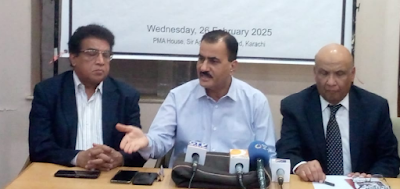Experts raise alarm over prevalence of HIV in voluntary blood donors in Sindh –I
*272 new HIV cases reported monthly since Jan 2023, primarily among high-risk groups; Virus may exceed 0.1% threshold in general population.*
By Mukhtar Alam
KARACHI: With an average of 272 new HIV cases reported every month since January 2023 across Sindh, primarily among high-risk populations, infectious disease experts have raised alarm as additional data from registered blood banks—involving voluntary and exchange donors only—suggests that the virus may have exceeded the largely satiating threshold of 0.1% among the general population in the province.
Experts
have emphasised the need for overhauling provincial prevention and control
mechanisms as well as the activation of the long-notified but inactive
provincial guiding body on HIV –Sindh AIDS Commission.
A study of
HIV data acquired from the provincial health department revealed that during
2023 and 2024 (till August), Sindh had a total of 5,444 new people living with
HIV. Men accounted for 61% (3,342) of the cases, including 438 male children,
while women comprised 30% (1,636), including 276 female children. Transgender
persons accounted for 8% (429) of the cases.
The data
highlights an increase of 22% in new HIV cases over the past two years. An
11-year accumulated figure shows 24,891 people living with HIV in Sindh.
A review
of the 11-year data reveals a steady increase in HIV cases from 2014 to 2018
(55.6%), followed by a significant spike in 2019 (61.1% increase from 2018).
After a decline in 2020, cases increased in 2021 and 2022 (24.1% and 27.9%,
respectively). The 2023 data shows a significant increase (16.1%) compared to
2022, while the 2024 (till August) data shows a decrease (–28% from 2023) in
such cases.
Data compiled by the CDC-HIV component of the Sindh Health Department in 2023 highlighted the primary modes of HIV transmission. Sexual transmission accounted for 7,901 cases, followed by reuse of contaminated needles/injections or sharing (6,911 cases), transfusion of blood or blood products (2,131 cases), mother-to-child transmission (1,069 cases), occupational/healthcare settings (181 cases), and surgical-dental process (12 cases). Additionally, 2,128 cases had undisclosed transmission methods.
Meanwhile,
another study of data relevant to results of scanning of blood bags donated by
voluntary and exchange donors in 2023 and 2024 at the four regional blood banks
and blood banks registered with the Sindh Blood Transfusion Authority (SBTA)
highlights the importance of continued vigilance and robust screening protocols
to ensure the safety of blood supply in Sindh.
Findings:
The overall HIV positivity rate among blood bags ranges between 0.05% and 0.5%
across different regional blood centers. The HIV positivity rate varies
significantly across regions, with RBC Sukkur showing the highest rate of 0.5%
in 2024 and JPMC Blood Bank showing the lowest rate of 0.05% in 2023.
Most of regional blood centres showed consistent HIV positivity rates between 2023 and 2024, with some fluctuations. The Sindh Blood Transfusion Authority (SBTA) data showed an overall HIV positivity rate of 0.15% in 2023 and 0.1% in 2024. RBC Jamshoro and SBTA showed consistent HIV positivity rates between 2023 and 2024.
An infectious disease expert said that the given situation demands immediate attention and action to prevent further spread of the virus, stressing that the government must take concrete steps to address the rising HIV cases in Sindh.
The expert
recalled a UNAIDS country progress report in the case of Pakistan (2020),
saying the HIV epidemic in Pakistan is following the Asian Epidemic Modelling
trend i.e. the epidemic has nearly plateaued in people who inject drugs and
moved into the sexual networks from where a gradual spill-over into the general
population through bridging populations is silently taking place.
“In Pakistan, although the estimated prevalence of HIV among the general population is less than 0.1%, the fifth Integrated Biological and Behavioural Surveillance (IBBS) Round conducted in 2016 revealed a steady increase in the weighted prevalence of HIV among the key populations namely: PWID = 38.4%, TGSW = 7.5%, TGs = 7.1%, MSW = 5.6%, MSM = 5.4%, and FSW = 2.2%.”
According to a research paper published in the WHO South-East Asia Journal of Public Health (2015), the annual prevalence of HIV in donors at the Aga Khan University blood banks ranged from 0.013% to 0.116%.
Courtesy: Social Track, weekly







Comments
Post a Comment